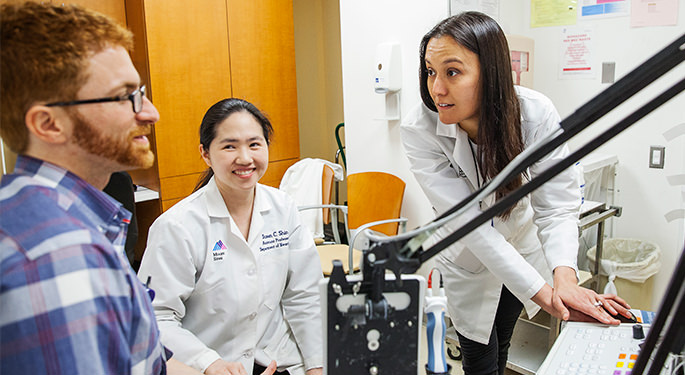Neuropathy

Peripheral neuropathy is the most common disorder of the peripheral nervous system. Damage to peripheral nerves can result in numbness, pain, and weakness. Neuropathy typically affects the hands and feet but can involve other parts of the body.
Symptoms of Neuropathy
If you have neuropathy, you may experience a gradual onset of numbness and tingling in the hands and feet. Other symptoms of neuropathy include burning, prickling, or stabbing pain, heightened sensitivity to touch, imbalance when walking, and weakness. Symptoms of neuropathy that affect autonomic nerves can include dry mouth and eyes, light-headedness, and constipation.
Causes of Neuropathy
There are many causes of neuropathy including diabetes, alcoholism, medical treatments (such as chemotherapy), exposure to environmental toxins (such as lead), infections (including HIV, hepatitis C, Lyme disease, and syphilis), vitamin deficiencies, connective tissue disorders (such as lupus, Sjogren’s syndrome, and vasculitis), trauma to a nerve, tumors of a peripheral nerve, and systematic illness that result in chronic liver or kidney failure.
Inherited forms of neuropathy are caused by specific genetic mutations. Autoimmune neuropathies are acquired immune-mediated disorders in which the body’s immune system attacks parts of the peripheral nerves.
Treatments for Neuropathy
Treatment of neuropathy depends on finding the specific cause and controlling it. For instance, if the neuropathy is caused by an infection, we must treat the infection; if it is caused by pressure on a nerve, we need to alleviate the pressure.
We can treat autoimmune neuropathies with intravenous immunoglobulin, plasma exchange, and immunosuppressive medications. Our treatment of neuropathic pain incorporates an integral approach with a combination of oral pain relievers, topical pain relievers including capsaicin patch, physical therapy, and holistic approaches such as acupuncture and meditation.
Capsaicin Patch
Capsaicin is the substance in chili peppers that gives you a burning sensation when you eat hot, spicy foods. When applied to certain painful skin conditions, it produces an initial burning sensation, followed by pain relief. A high-concentration capsaicin patch is used for the treatment of certain painful peripheral neuropathies.
Mount Sinai Hospital neurologists led research on the high-concentration capsaicin patch and have trained physicians around the world on how to use this treatment. Marketed as Qutenza®, it is now available to treat post-herpetic neuralgia (persistent pain after shingles rash) and other types of painful neuropathies.
To determine whether the capsaicin patch is right for you, your doctor will conduct an initial office evaluation. The patch itself is applied during a clinic visit, which begins with your doctor identifying the area of skin where you experience the most pain. An anesthetic cream is applied to this area, left for one hour, then washed off. Your doctor then applies the capsaicin patch and leaves it on for 30 to 60 minutes. You may require more than one patch.
After application, you might feel a burning sensation, like a sunburn. If the discomfort becomes too intense, you will receive oral pain medications, but many patients do not feel increased discomfort. After we remove the patch, your skin may be slightly red, but this is not dangerous. You may then go home.
Over the next day or two, you may experience discomfort from the procedure. You can use oral pain medication if needed. Within days of applying the capsaicin patch, most patients experience significant pain relief in the target area, which lasts about three months. We can repeat treatment as necessary.
Acupuncture
Acupuncture can be an effective treatment for chronic pain. This procedure consists of inserting very fine needles in specific points in the body. Sometimes we apply a small amount of electricity to the needles, which can make the treatment more effective. Acupuncture has been shown to improve pain by boosting the body’s natural painkillers and improving blood flow.
Research has shown that acupuncture is useful in treating back and neck pain, headaches, and pain from osteoarthritis, and it can also help neuropathic pain.